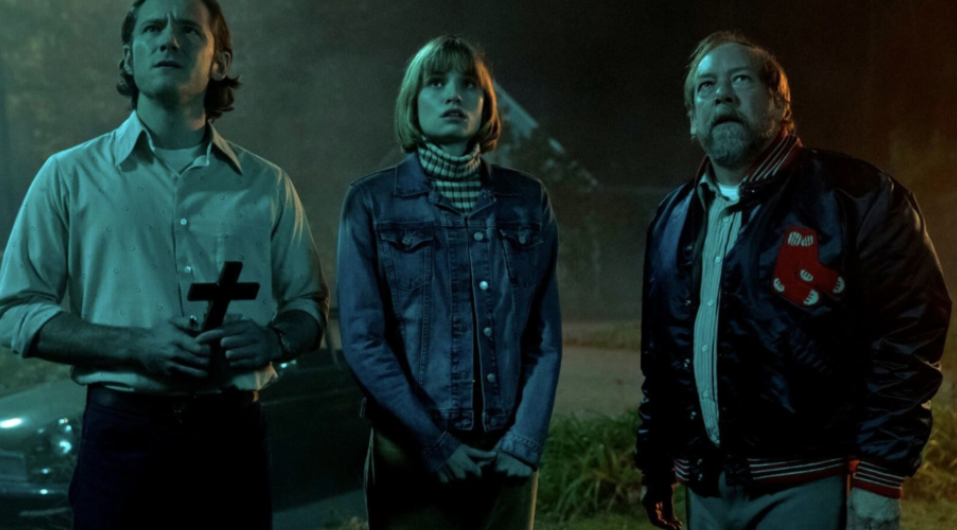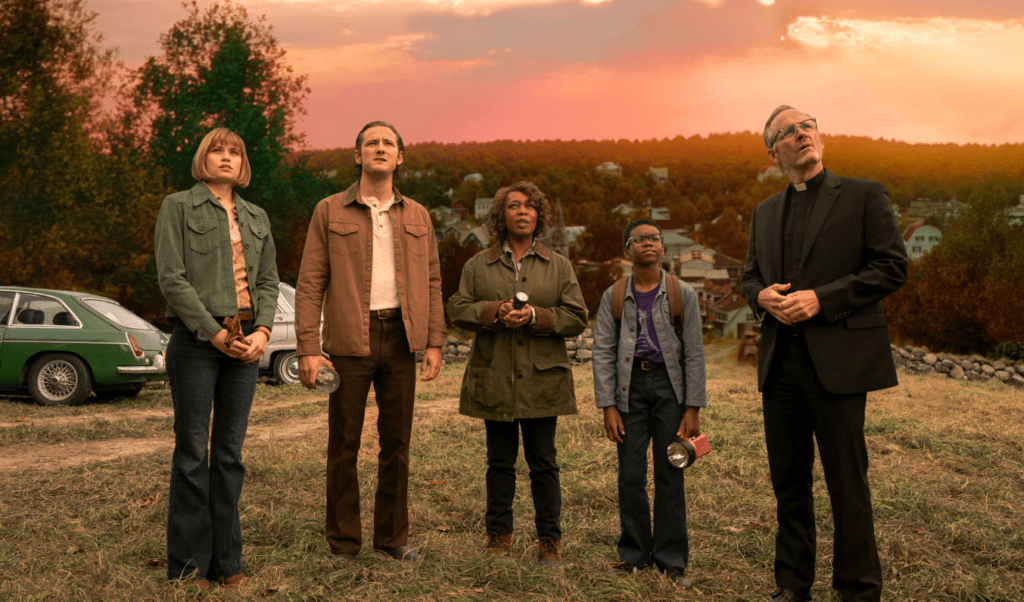Salem’s Lot Review: A Chilling Yet Imperfect Adaptation of Stephen King’s Vampire Classic
Stephen King’s works have long been a source of inspiration for the horror genre, with countless adaptations making their way to the big and small screens. From the iconic “The Shawshank Redemption” to the terrifying “IT,” some adaptations capture the essence of King’s masterful storytelling, while others falter under the pressure. The latest adaptation of Salem’s Lot, King’s second novel, sits somewhere in between. It offers moments of brilliance and atmosphere but stumbles in certain areas, leaving viewers divided.

Lewis Pullman leads the cast as Ben Mears, a writer who returns to his hometown of Jerusalem’s Lot (commonly known as Salem’s Lot) in search of inspiration for his new book. However, what he uncovers is far more sinister than mere writer’s block vampires have started to take over the town, and Mears must rally the locals to stop the impending doom.
Nostalgia Meets Horror: A Retro Setting
One of the standout choices in this adaptation is director Gary Dauberman’s decision to maintain the novel’s original 1970s setting. While this may initially seem like a nostalgic homage to King’s roots, the execution doesn’t fully capitalize on the retro charm. At first glance, the quaint small-town vibe and vintage aesthetics do create an old-school atmosphere. However, as the story progresses, the period setting begins to feel more like a backdrop rather than an essential part of the story.
The 1979 TV miniseries of Salem’s Lot had a unique, eerie tone that became a staple of horror for that era. In contrast, this new version struggles to evoke the same level of tension. While the original set the standard for supernatural horror, this version tries but falls short of capturing that same cultural impact.
The Cast: Stellar Performances but Limited Depth
Lewis Pullman, son of veteran actor Bill Pullman, takes on the role of Ben Mears with a quiet determination, perfectly suited for the reflective nature of the character. He embodies the heroism and curiosity that a Stephen King protagonist demands. However, despite Pullman’s effort, the supporting cast struggles to elevate the material in a meaningful way.
Alfre Woodard, a respected actress, plays Dr.Cody, a cynical yet compassionate local doctor who becomes an ally to Mears. While Woodard’s performance adds some gravitas to the film, her character doesn’t get enough development to leave a lasting impression. Similarly, John Benjamin Hickey’s portrayal of Father Callahan, the town’s conflicted alcoholic priest, lacks the complexity that could have added layers to his role as a protector of the community.
Vampires Without Bite: Lacklustre Villains and Missed Opportunities
When it comes to vampires, audiences expect a mixture of terror and allure creatures who are both captivating and terrifying. Unfortunately, the vampires in this adaptation fail to leave much of an impression. Kurt Barlow, the film’s primary antagonist, played by Alexander Ward, is undoubtedly menacing, but his portrayal lacks the sheer terror that made him such a powerful force in King’s novel.

Ward’s restrained performance is unsettling at times, with his cold and calculating demeanour, but it lacks the depth that could have made him a truly memorable villain. The vampires themselves feel more like relics of horror’s past neither scary nor charismatic enough to leave a lasting mark on viewers.
Atmosphere and Cinematography: Eerie but Predictable
One area where Salem’s Lot shines is in its atmospheric design. The town of Jerusalem’s Lot is a character in its own right, with its dilapidated houses, fog-filled streets, and shadowy corners providing a fitting backdrop for a horror story. Cinematographer Michael Burgess uses light and shadow masterfully, creating moments of genuine suspense and unease.
There are scenes where the film successfully captures the creeping dread that King is known for, especially during key sequences when the vampires begin to take over the town. The fog that envelops the streets, the flickering street lamps, and the decaying town square all contribute to a sense of isolation and despair that fits perfectly with the story’s themes.
However, despite the film’s visual strengths, much of the tension is predictable. Fans of the genre might see certain jump scares and plot twists coming from a mile away, which detracts from the film’s overall impact.
Pacing: A Slow Burn that Doesn’t Fully Pay Off
Stephen King’s novels often rely on slow-burn storytelling, where the horror gradually builds until it becomes overwhelming. Salem’s Lot follows this formula, with the first half of the film focusing heavily on character development and establishing the town’s eerie atmosphere. This slower pacing may appeal to fans of more methodical horror, but for those seeking immediate thrills, it could feel tedious.
As the film moves towards its climax, the pace quickens, with more action-driven scenes and an increase in horror elements. However, the transition from slow-burn suspense to full-blown horror isn’t always smooth, leaving some scenes feeling rushed or lacking in emotional payoff.
Themes and Symbolism: A Missed Opportunity for Deeper Meaning
One of the reasons vampire films have endured for so long is their ability to serve as metaphors for a wide range of human experiences desire, loneliness, and even political oppression. Films like Let the Right One In and El Conde use vampires to explore complex themes, while Salem’s Lot sticks to a more straightforward narrative.
While there’s nothing inherently wrong with a classic vampire tale, this adaptation’s lack of subtext feels like a missed opportunity. There are hints of deeper themes, such as isolation, fear of the unknown, and the loss of innocence, but they are never fully explored. The film stays focused on the literal horror of the vampires, without delving into the psychological or symbolic layers that could have elevated the story.
Practical Effects and Set Pieces: Hits and Misses
One of the film’s strengths is its use of practical effects, particularly when it comes to the vampires themselves. The makeup and prosthetics give the creatures a grotesque, otherworldly appearance that enhances their menace. However, these effects are used sparingly, which makes their impact less pronounced.
The film’s major set pieces, such as the final showdown between the townspeople and Barlow’s minions, are visually striking but lack the emotional weight needed to make them truly memorable. While the action is intense, the film’s uneven pacing and underdeveloped characters mean that viewers may not feel fully invested in the outcome.
The Verdict: A Worthy but Imperfect Adaptation
Overall, Gary Dauberman’s Salem’s Lot is a visually impressive and atmospheric adaptation of Stephen King’s novel, but it falls short of becoming a true horror classic. While it successfully captures the eerie small-town setting and offers some genuinely chilling moments, its lacklustre vampires, underdeveloped characters, and uneven pacing prevent it from reaching its full potential.
For fans of Stephen King and supernatural horror, Salem’s Lot is still worth watching, but it may not leave the lasting impression that other King adaptations have. It’s a solid entry into the vampire genre, but it doesn’t quite rise to the level of a classic.
FAQs
1. Is Salem’s Lot a faithful adaptation of the book?
Yes, for the most part, Salem’s Lot sticks closely to the source material, maintaining the central plot and characters from Stephen King’s novel. However, some elements, such as character development and deeper thematic exploration, are not as fleshed out as in the book.
2. How does this adaptation compare to the 1979 miniseries?
The 1979 version is considered a classic, with a tone that resonated deeply with audiences at the time. This new adaptation offers a more modern take with updated effects and cinematography but doesn’t quite capture the same level of tension or cultural impact.
3. Is Salem’s Lot scary?
The film has moments of genuine suspense and horror, especially in its atmospheric build-up. However, the vampires themselves aren’t as terrifying as they could be, and some viewers may find the scares to be more predictable than shocking.
4. Who stars in the film?
The main cast includes Lewis Pullman as Ben Mears, Makenzie Leigh as Susan Norton, Alfre Woodard as Dr. Cody, and John Benjamin Hickey as Father Callahan.
5. Is the 70s setting important to the story?
The 1970s setting adds a nostalgic layer to the film, but it doesn’t play a crucial role in the narrative. The story could have been set in any era without significant changes to the plot.
6. Should I watch Salem’s Lot if I’m a fan of Stephen King?
If you’re a fan of King’s work and enjoy vampire stories, Salem’s Lot is worth checking out. While it’s not a perfect adaptation, it offers enough atmospheric horror and character moments to keep fans engaged.





